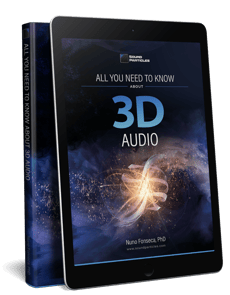Confused with all the 3D Audio terms that keep coming up? Have you tried searching for answers, only to find them scattered through several articles and guides? This quick guide offers you a summary of what you need to know and what the future holds for Immersive Sound.
What is immersive audio?
You've probably been hearing about all these new industry concepts that have piqued your interest but you may not understand at first, such as 7.1.2, VBAP, 22.2, objects, beds, B-format, AmbiX, ACN, SN3D, HRTF, HRIR.
Immersive Audio is the next big thing in the entertainment industry. Cinema, TV, VR/AR, Videogames, Music, Installations - everyone is moving to 3D audio as a way to immerse audiences and improve their experiences. However 3D audio brings new concepts and some new/old technologies that you may not understand just yet.
Understanding these concepts is the key to integrating 3D audio into your workflow - which really is the answer to all your sound related problems. It's a complex medium, but we're here to help you understand and navigate this new world of immersive audio.
Why is immersive sound the next big thing in audio?
Long gone are the days where a casual music listener or moviegoer accepted the standards of a simple stereo mix when consuming their media content.
Audience goers and music lovers nowadays are much more knowledgeable than they used to be and their expectations have really gone through the roof as the years have gone by and new technologies have been introduced in the mainstream media - like unbelievable VR, highly immersive live shows or incredibly complex movie soundscapes.
To adapt to this new demand is to ensure you're staying ahead in this industry. All we need to do is look at the latest announcement of the PS5, where one of their biggest selling points is 3D Audio - and how that is setting them apart from the competition.
If you've just had a casual interest in 3D Audio until now but never thought it was time to start actively using it yet - now is that time. It's time to learn all about the different aspect of 3D sound - all the ins and outs of channel-based audio, the advantages and disadvantages of object-based audio, the inner workings of ambisonics and all its variations, and everything that goes into making a binaural experience completely customized to each single listener.
What does the future hold for 3D sound?
By now I hope you realize the potential regarding 3D sound: how important it is to understand how it works and how we can use it; what the different systems are and how they're used; and a desire to better understand this world of 3D audio that is now exploding everywhere from cinema to TV, from videogames to music, from VR to many other applications.
In our newly released eBook "ALL YOU NEED TO KNOW ABOUT 3D AUDIO", we dive in detail into all of these concepts, what the advantages and disadvantages are of each of these, and even add some interesting facts and stories about Hollywood.

3D Audio questions the ebook will answer for you
- Why are stereo speakers supposed to be placed with an angle around 60 degrees?
- Why would you need a central speaker between the right and left speakers?
- Why is the difference between a LFE and a subwoofer?
- Is there a format where a single mix is able to automatically adapt to different speaker layouts?
- Did you know that Disney's Fantasia (the 1940 movie which includes the famous scene with Mickey Mouse with the Sorcerer's Hat) is considered to be the first movie to use surround sound - as well as the first one to use immersive sound?
- Did you know that 3D Audio playback on headphones works differently for every single person?
- Did you know Japan has its own Immersive Audio system which considers over 20 channels?
These are wonderful times for everyone that loves spatial audio... and you can always use Sound Particles software as your playground, which supports most of these formats.
About the author
 Nuno Fonseca (PhD), is the founder and CEO of Sound Particles company, and was the creator of Sound Particles software, a 3D CGI-like audio software used in all major Hollywood studios in productions such as “Star Wars 9”, “Frozen II”, or “Game of Thrones”.
Nuno Fonseca (PhD), is the founder and CEO of Sound Particles company, and was the creator of Sound Particles software, a 3D CGI-like audio software used in all major Hollywood studios in productions such as “Star Wars 9”, “Frozen II”, or “Game of Thrones”.
Former university professor (computer science and music technology areas), Nuno is the author of the Portuguese book “Introdução à Engenharia de Som” (Introduction to Sound Engineering), co-author of the Portuguese book “Desenvolvimento em iOS” (iOS Development), and author of more than 20 papers regarding audio research.
He is a member of AES, SMPTE, CAS, MPSE, AMPS, and member of the Audio Engineering Society (AES) Technical Committee on “Audio for Cinema”.
Topics: Sound Particles, Audio Software, Sound Design, Film, Cinema, Sound for Film and TV, Audio tech, 3D audio, Surround Sound, Gaming Audio

